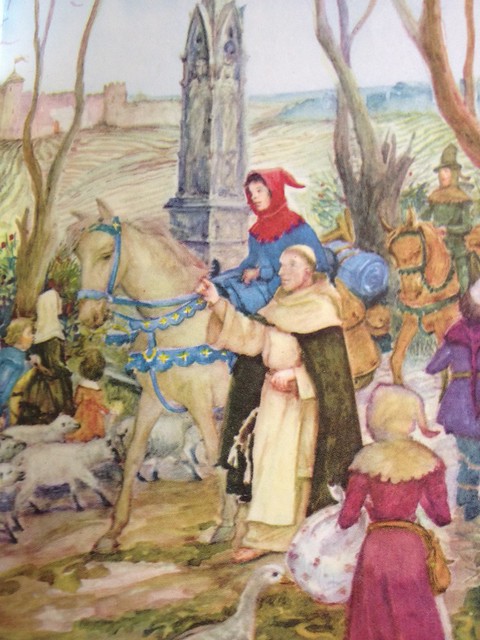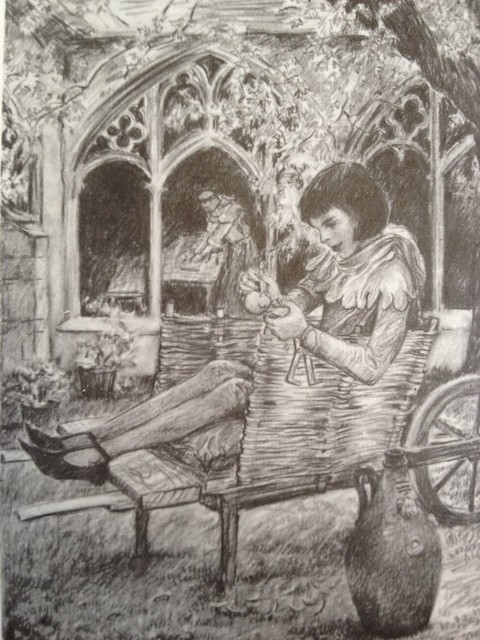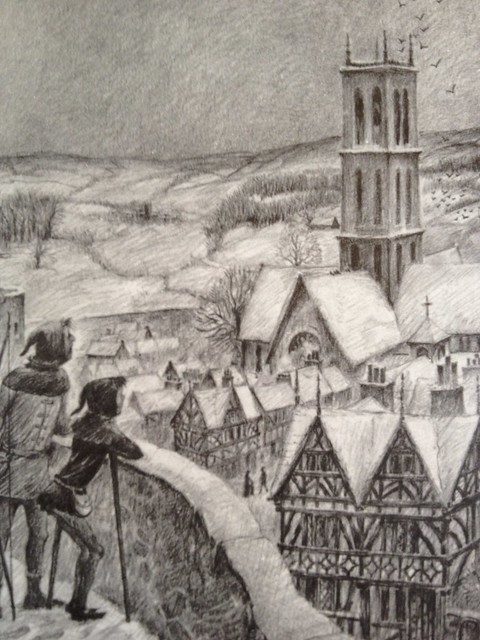The protagonist, young Robin, is a bit of a brat at the beginning of the story, but if you consider his circumstances. At the age of ten he is deemed old enough to not be a child anymore. His parents arrange to ship him off to a friend's, Sir Peter de Lindsay's castle to begin his training as a knight. His father has been away for quite some time, fighting with the King against the Scots. His mother has gone to become a lady-in-waiting to the Queen, leaving Robin with their servants until someone comes to take him to his new home, while the plague is raging through London. But soon after his mother leaves, Robin contracts a serious illness that leaves him lame. Little by little he is left alone, as his servants either get the plague, or abandon him and London to escape it. His last remaining servant, Dame Ellen, is also struck down with the plague. Luckily for Robin, Brother Luke at the neighboring monastery, St. Mark's, finds out about Ellen and comes to check on the boy and take him in.
This is pretty heavy stuff for a book aimed at 3rd grade and up. It may move a little slowly at first for today's kids, who have been raised on sparkly vampires and Spongebob. It's a bit like the classic The Secret Garden in terms of pacing. The action takes place in the 1300s, an era that may seem too far away to be interesting, but The Door in the Wall struck a chord. As I was reading I couldn't help but think a bit of Bran from Game of Thrones, and some other current pop culture references, especially Artie and Quinn's current storyline on Glee. It was nice to read an older novel (the book was published in 1949 and won the 1950 Newbery medal) and see such a positive story centered around a disabled character.
How many 10 year olds would cope as well as Robin with suddenly not being able to walk, or run, or play— or being told by their parents that their childhood was essentially over and that they were being shipped off to live in a stranger's house? Robin may not immediately know what Brother Luke means when he tells him, "Thou hast only to follow the wall far enough and there will be a door in it," but he soon comes to understand.
The Door in the Wall's metaphor's may be a little predictable, but it is far from an easy or predictable read. Robin and his two closest friends, Brother Luke and the minstrel John-go-in-the-Wynd, are forced to deal with many difficult issues: the plague, illness, dangerous travel, a castle siege. De Angeli does a nice job of depicting the daily life of the 14th century, and of the part of England Robin travels through,
"'The weather was neither rainy nor fair, neither hot nor cold, but somewhere in between, as English weather is like to be,' said the friar."
The Door in the Wall may be a children's book, but she doesn't shy away from using some words that may require looking up: pease porridge, flambeaux, bannock. A glossary would have been useful. An added bonus are the beautiful illustrations by de Angeli, in color and black and white, that are found throughout the story.
It was interesting reading how Robin and everyone he encountered dealt with his illness/infirmity. The virus or illness that causes Robin to lose the use of his legs is never named, but it sounds a lot like polio. Robin, of course, hopes to recover use of his legs, and quickly. Brother Luke never shoots that idea down, but keeps introducing Robin to other goals he can achieve in the present. He helps him build his upper body strength by encouraging him to swim daily, as well as taking part in other activities that engage both his mind and body — woodcarving, archery, and learning to read and write.
Robin is never made to feel that his physical handicap is a burden or couldn't be dealt with. He was able to travel, swim, and eventually becomes strong enough to both carve and use his own crutches. By the time that he has to accept that he may probably not recover the use of his legs he has already found so many ways to be useful and independent that it no longer seems as great a concern for him — his major worry is how his parents might react to the change in him since they had last seen each other. But readers can be assured that Robin's story ends happily. The Door in the Wall is a nice trip into the past, as well as a look at how even the most daunting obstacles can be overcome if you are able to look at things from another angle, use a different approach.





2 comments:
My mother brought that book home from the library one day when I was sick in bed, and I remember it with great fondness. I'm glad to see it's still around, and that others responded to it the same way I did.--Mario
I had Jared's Island by de Angeli, which was set near the part of southern New Jersey where I grew up. I loved that book. We also had The Old testament, illustrated for children. I bet it's still somewhere around here in my mom's bookcases, I'll have to search for it. This was a very welcome discovery. : )
Post a Comment